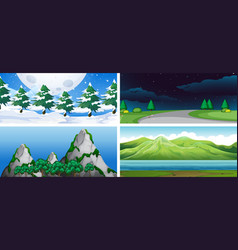

Rivers, linear features, administrative borders, and highways are examples of vector data. In contrast to the usage of pixels in raster data, vector data vertices or sequential points are employed for data representation. The pixels are neatly grouped in a grid of columns and rows. Raster data is made up of pixels, each of which has a value that reflects information such as temperature and chemical concentrations. Raster images are scanned maps, satellite images, digitalized aerial photography, or digital photographs.

The distinction between raster and vector data in GIS
#Vector or raster for natural landscape software
When utilized in different software and for different reasons, each of them has its own advantage. Raster images are composed of pixels, but vector images are composed of geometrical objects such as lines, curves, and polygons.įurthermore, Raster graphics are not scalable since the quantity and dimensions of the pixel remain constant, whereas Vector graphics are easily scalable because their dimensions alter using a simple mathematical equation.

As a result, the final image is fairly clear. The same mathematical method is used to adjust the dimensions of an image when it is resized. It cannot, however, be employed in digital photography or remote sensing.Įach Vector image is made up of a mathematical formula that specifies the coordinates, colors, and measurements of the geometric forms. This method is preferred in industries including architecture, engineering, typography, surveying, and 3D rendering. It creates visual images by using geometric shapes such as points, curves, lines, squares, and polygons. Vector, like Raster, is a frequently used method in computer graphics. These programs manipulate each individual pixel in the image. Raster pictures, on the other hand, are commonly utilized in editors like as Paint Shop Pro, Adobe Photoshop, Microsoft Paint, and even Coral Painter. However, the majority of them are compressed to prevent taking up a lot of RAMS. Surprisingly, the majority of photos stored on a computer are in Raster format. These pixels are arranged in a certain pixel format, which is then used to create a Raster grid. This value determines the apparent color as well as the pixel’s dimensions. As a result, the resulting image is frequently fuzzy.Ī Raster image has a single numeric value for each pixel. When resized, the pixels do not increase in number, but rather in size. This is due to the fact that they are only made up of a limited number of pixels.


 0 kommentar(er)
0 kommentar(er)
